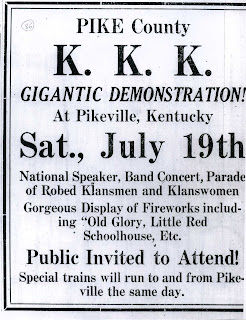A reading of the Pike County News over a period of time will leave the reader with the impression that the major disease problem was typhoid. Typhoid is an illness caused by a bacteria found in human waste. The disease is spread when the bacteria enter food or drinking water and are consumed. Today, typhoid is found almost always in countries outside the developed world and is usually treated successfully by antibiotics. Unfortunately, antibiotics were not developed until the late 1920s. So it was not rare to see a short article like that on March 21, 1924, which declared that Pike County was in the midst of a typhoid outbreak. On November 24, 1924, the paper reported that a family of 12 had been reduced to three in a few weeks due to typhoid. May 21, 1926 had this report in the Jonancy community news:
JONANCY NEWS
“Floyd Hall, the little son of Mrs. W. T. Hall, who has been suffering with hip and shoulder trouble ever since his attack of typhoid fever last October, went to Pikeville last Friday to consult a doctor and to get relief if possible. The trouble has become quite serious.”
This statement appeared November 12, 1926:
MOTHER DIES OF TYPHOID; 4 ARE ILL
A mother and four of her children were brought to the hospital suffering from typhoid fever. Mrs. Merlie Branham of Lookout died, and the four children are not expected to live.
